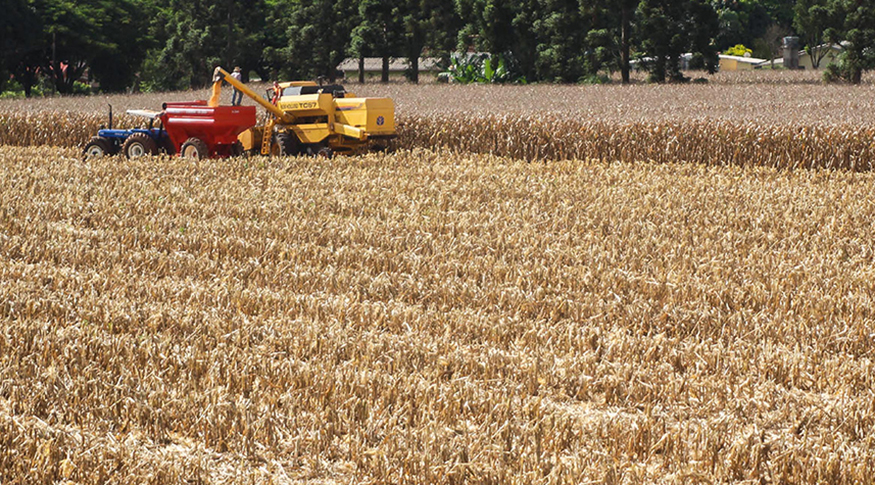Agricultural production
June estimate points to record harvest of 258.5 million metric tons in 2021
July 08, 2021 09h00 AM | Last Updated: July 09, 2021 11h38 PM

The Brazilian Harvest of grains, cereals and oilseeds is expected to reach a record 258.5 million metric tons in 2021, according to the June estimate of the Systematic Survey of Agricultural Production (LSPA), released by the IBGE. For the third month in a row, there was decrease in the monthly estimate. Despite the retraction Against the May estimate, production this year is supposed to be 1.7% above that of 2020, which reached 254.1 million metric tons..
There was a decrease of 1.6% against the previous estimate, which means a reduction by 4.2 million metric tons. As in the two previous months, the decrease was mainly a consequence of the decrease in crop harvest. In June, that crop faced a drop of 4.1 million metric tons (-5.6%) against the latest estimate. According to the survey analyst Carlos Barradas, retraction is due to the reduction of the window of planting dates of this grain and to the lack of rain in some producing states such as Goiás, Minas Gerais, Paraná and Mato Grosso do Sul.
“Planting of the second crop of corn was late due to the delay in the harvesting of soybean. So, as this period was reduced, the crop was more dependent on rainfall. As a result, in June, the second crop of corn was even more reduced due to the prolonging of dry weather conditions in these regions,” Mr. Barrada says.
The second crop represents 72.8% of corn production. With the sum of two crops, this grain is expected to amount to 95 million metric tons in 2021. Compared to what was produced last year, there was a decrease by 8%, although producers have invested in the expansion of planting areas (6.5%) and harvesting areas (6.7%).
Corn, rice and soybeans are the three main products in the group of grains, cereals and oilseeds. They account for 92.6% of the output estimate and for 87.9% of the area to be harvested. Rice crops are expected to reach 11.2 million metric tons in 2021, with a decrease of 1.2% against the estimate of May and an increase of 1.5% against the overall amount produced last year. According to Mr. Barradas, despite the reduced estimate caused by the lower productivity of crops, output is enough to supply the domestic market.
Soybeans, the crop with the biggest participation in the total output of grains, is expected to hit another record this year: 133.3 million metric tons. That represents an increase of 0.3% from the previous month and of 9.7% against the total produced last year. “Despite the delay in planting, the estimate is that production reaches a new record. The dry weather caused damage to soybean crops, but, from December on, rainfall went back to normal and crops recovered.” The researcher explains that, in some states, there was decrease in productivity, but the expansion of planting area by producers is one of the factors that account for the increased output of this grain.
Another crop that recorded an increase in estimate was wheat, whose production must reach 7.9 million metric tons. There was an increase of 0.1% Against the estimate in the previous month and of 26.8% in the total produced in 2020. Last year, crops in the South were affected by climate problems, and that reduced their productivity.
Output in the Central West may fall by 4.3% in 2021
Four of the five Major Regions recorded increase in output estimates in relation to the overall produced last year: South (10.2%), Southeast (3.4%), Northeast (5.3%) and North (0.2%). The Central West, which accounts for 45.1% of the national output of grains, cereals and oilseeds, is expected to record a 4.3% decrease in output. Among Federation Units, Mato Grosso ranks as number one, with a share of 27.4% of the national, followed by Paraná (14.7%), Rio Grande do Sul (14.2%), Goiás (9.2%), Mato Grosso do Sul (8.2%) and Minas Gerais (6.3%), which, together, amounted to 80.0% of the overall national output.
About the survey
Implemented in November 1972 aiming at meeting the demand of users for short-term statistical information, the LSPA provides estimates of planted area, harvested area, amount produced and average yield of products selected based on criteria of social and economic importance to Brazil. It not only monitors each crop investigated in the calendar year of reference, starting with the intention to plant up and to the end of the harvest, but also produces harvest forecasts for the coming year, for which the months of October, November and December are surveyed. Please access the data atSidra.




















